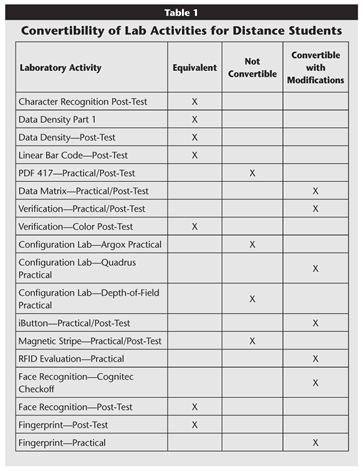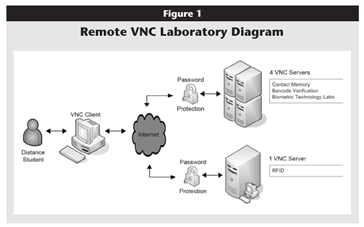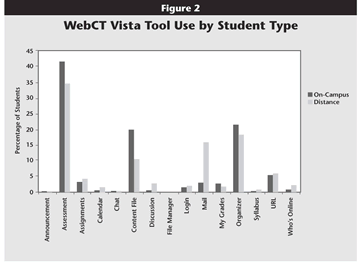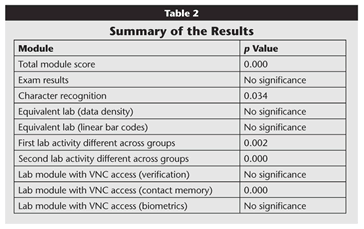Distance education as a stand-alone approach has grown tremendously in the past 10 years. The distance approach to education offers numerous benefits1:
- Accommodates different learning styles and schedules
- Uses various educational resources or media (paper, video, audio, online) as instructional tools
- Allows use of multiple communication methods (e-mail, teleconference, video conference, instant messaging)
- Supports self-directed and self-paced learning style and method
Many students choose this type of education because full-time jobs, physical limitations, or other commitments prevent their participation in more traditional approaches to instruction.
The other form of distance education, often called hybrid, supplements traditional classroom instruction with online resources. The instructors deliver classroom lectures, but homework, assignments, and supplemental material may be retrieved online.
Automatic Identification and Data Capture (AIDC) is a junior-level course offered for a number of years to students predominately in the Industrial Technology and Computer Information Technology fields of study at Purdue University. Adoption of this course as part of the bachelor of science degree in Industrial Technology in 2002 by a number of Purdue University College of Technology sites across the state necessitated an evaluation of how to proceed with a laboratory-intensive course, to those distance sites that did not have comprehensive laboratory facilities.
For two years, we offered on-campus and online versions of the course. We used a hybrid approach for the on-campus offering of the course, posting assignments, readings, and quizzes online in addition to classroom lectures. WebCT Vista in the laboratory environment provided resources for students, such as videos, audio files, and laboratory instruction material. The distance education students interacted in asynchronous instruction, allowing them to choose their own instructional time frame and complete learning materials according to their schedules.2
We studied the performance of the two groups of students, and in this article we discuss our experiences in the fall 2005 AIDC class of 69 on-campus students and 6 distance education students, acknowledging the limited data set in the distance education cohort. The lab modules offered a particular challenge. Early studies found that the performance of both groups of students was equivalent when activities could be presented equally. When the lab exercises could not be effectively transferred to a distance format, performance of the two groups differed significantly. In the study reported here, however, where performance for the two groups was the same for some activities and different for others, the students' prior knowledge and competence with computers seem to have contributed to the results.
Transforming the Lab into a Virtual Environment
Initially, all of the lecture assignments, laboratory assessments, and exams in the course were exclusively paper-based. When the university adopted WebCT Campus Edition course software, additional material was developed to take advantage of the new technology. For the fall 2003 semester, the instructors and lab assistants migrated the course to a truly online environment. We divided the course into modules, each of which covers an individual or group of related AIDC technologies. Course material was available electronically, and tests were graded automatically by the course management system when applicable.
The WebCT Vista portal was instrumental in the department's ability to offer this course to distance students. The technology made it possible for distance students to complete and submit material at their convenience. Nevertheless, two main issues remained:
- How would the instructors present lecture material?
- How would the instructors deliver—and allow students to complete—the laboratory activities?
Each AIDC technology module was assessed to see whether modifications would be needed to enable distance students to participate fully in the laboratory activity. The modules included lectures as well as laboratory exercises, meaning both the presentation and the content of the module components required scrutiny.
A review of the literature revealed a number of ways to provide laboratory experiences to distance students. Methods included LabVIEW, Virtual Network Computing (VNC) software, or providing the software on a CD-ROM for students to execute at home.3 A combination of the latter two strategies was chosen by the instructor and lab assistants for a number of reasons. First, we wanted to limit computer support issues. In addition, we were unsure of distance students' Internet connectivity (bandwidth), so provided students with new versions of freely available Internet browser installation files, VNC software installation files used in the course, and some course materials.
Lecture Materials
To provide students with the lecture materials and to ensure that both distance and on-campus students received the same material, each on-campus lecture was videotaped, digitized, and posted to a streaming server. Additionally, distance students received a CD containing the software necessary to remotely connect to designated on-campus host computers, as well as software or videos for specific laboratory exercises.
Equipment Requirements
All the laboratory activities were evaluated to ensure the remote accessibility via the Internet was acceptable for distance education. There were three categories of remote accessibility:
- The laboratory activities were equivalent, with no differences detected between the coursework that distance and on-campus students would complete.
- The laboratory was not convertible, that is, students had to physically interact with the equipment.
- The laboratory was convertible with some modifications.
Table 1 shows the results of the assessment of the course's various laboratory activities.

Click image for larger view.
An evaluation of the scores revealed that the course covered too much information, so we reduced the number of labs from 23 activities to 18 to make it more manageable for the distance students. Since all but four of the modules delivered equivalent activities or could be modified to do so, the solution we chose—a RealVNC 4.0 server—allowed students to remotely connect to the on-campus computers and thereby simulate their physical presence (see Figure 1). The software, available as a free and fully functional download, enabled password-restricted access to the lab machines. A schedule was created allowing students to sign up for time slots to perform the lab activities on an IP-restricted computer. The purpose of IP restrictions was to lock out "duplicate" remote connections if a student was already connected to an on-campus host laboratory computer.

Click image for larger view.
Upon installation of the remote connection server and modifications to laboratory instructions, 80 percent of the course's laboratory exercises could be completed at a distance. Five computers in the laboratory were assigned for the course's lab modules and made available for access during specific time periods established by contacting the distance students to determine their preferences. Only one student could log in to a computer at a time. Two-hour blocks of time were allotted to each student to complete the laboratory exercises. Students could access the computers outside of their designated time period if doing so did not conflict with another distance student's time and if no on-campus laboratory sessions were in progress.
Time Online in WebCT Vista: On-Campus Versus Distance Students
We hypothesized that on-campus students would use WebCT Vista predominantly in the lab period, potentially spending longer in the program due to the laboratory activities. This was not the case, however. Distance students spent on average 22 minutes per session, as opposed to on-campus students' 17 minutes. The most active day and least active day were not the same either, the least active day for the on-campus students being the Saturday of spring break. For the distance students, the least active day was in April. For distance students, the most active hour of the day was 7:00 to 8:00 p.m.; for on-campus students, it was 3:00 to 4:00 p.m. For both groups, the least active hour of the day was between 5:00 and 6:00 a.m.
Figure 2 shows the breakdown of online tool use by group. Note that the percentage of distance students who used the mail, discussion, calendar, who's online, and syllabus tools exceeded the percentage of on-campus students who did. Although the distance education students had access to the instructor through regular e-mail, instant messaging, and telephone options, the majority of correspondence with off-campus students took place through the WebCT Vista tools.

Click image for larger view.
Assessing Student Outcomes
To establish a baseline and see whether the two groups had the same knowledge at the beginning of the course, all students took a 179-question pre-test. Post-tests assessed student learning and identified any differences in the scores between the on-campus and distance student populations.
The course was divided into 8 laboratory sections, each including 8 to 12 students of the 69 on-campus students enrolled. Two teaching assistants taught four sections each. All on-campus students attended the same lecture period. Each of the six distance students had access to a two-hour block of computing time for performing the laboratory experiments. Distance students had access to the recording of the lecture that on-campus students received.
Results
We conducted a statistical analysis and collected descriptive information to determine whether any differences existed in the average scores of distance versus on-campus students. An a level of 0.05 was used for all the statistical tests.
Module Score Analysis
Table 2 outlines the results from the individual laboratory activities. The total module score consisted of all students' post-test, assignment, and practical scores for each module (but not the exams), which were then compared by group. Analysis of variance (ANOVA) statistical test results indicated that a statistically significant difference existed between the distance education and on-campus students, using the raw scores from these activities. On-campus students had an average score of approximately 89 percent, compared to 76 percent for distance students. This resulted in a p value of 0.000. However, the r2 value suggested only 37.33 percent of the difference could be explained by the total modules score alone.

Click image for larger view.
The exam results of the two groups were not significantly different statistically—the on-campus group averaged 86 percent, and the distance students averaged 84 percent (a p value of 0.316). We investigated further to establish whether the differences were associated with either the modified or non-modified lab activities.
We analyzed each module across the two groups to examine where the differences in scores lay. For character recognition, the module post-test was equivalent—students read the material and watched the lecture online. The module also was equivalent in delivery and assessment, but the distance group had a mean score of 86 percent as opposed to the on-campus group score of 93 percent. At a = 0.05, we found a statistically significant difference between the groups (p = 0.034). This indicated a difference in scores between the two groups despite no difference in content or delivery. Anecdotal evidence hints that the distance group rushed through this module; as a group, they enter the class at different times in the first two weeks, due to enrollment and setting up of students' computer accounts. We will monitor this for future classes.
The second module covered topics related to data density. Again, this module was equivalent across both distance and on-campus groups, with no statistically significant difference across the groups (p = 0.805). The second part of this module examined linear bar codes. This section also was equivalent, and we found no statistically significant difference across the groups (p = 0.760).
The third module had differences in the lab activities. Students have to interact with the PDF 417 scanner and bar code (see Table 1), which is impossible to replicate for distance students. As expected, there was a statistically significant difference in the module scores. For the on-campus students, the average score was 99 percent as opposed to 86 percent for distance students (p = 0.002). For subsequent iterations of the course, we will videotape this lab activity for the distance group to aid in their learning.
The fourth module encompassed scanning technologies and had to be modified for the distance students. It was the first laboratory activity where the students had to interact with the RealVNC software. The students also had to watch a video of the laboratory activity. The scores for this activity were statistically different across the groups—the on-campus students had an average score of 78 percent, whereas the distance students scored 30 percent on average (p = 0.000). Further examination of the module score revealed some difficulties in using the software. About half of the distance students completed the post-test activity without finishing the entire laboratory module. Furthermore, a vast majority of the questions in the post-test related to either the video or slides, so the final module score did not depend heavily on the RealVNC software. We plan to modify this laboratory activity for the next distance-education cohort to improve their learning.
The fifth module covered printing and consisted of lecture material and readings from the textbook. A post-test distributed to both groups produced the same evaluation for distance and on-campus students.
The sixth module covered verification. This module has two different components, the first to assess whether students perceive differences in color and the second to access the RealVNC software to see how the verification software works. Interestingly, the results showed a statistically significant difference in scores from the color verification (which was identical to the on-campus section), but not statistically significantly different scores for the verification lab (which had been modified). The distance group had a wider spread of scores, indicating that some still had difficulty accessing the computers remotely.
The seventh module covered card technologies, radio frequency identification (RFID), and contact memory. The card technologies activity could not be converted, but the RFID and contact memory activities were modified using the RealVNC software. All activities in this module showed statistically significant differences across the groups. We attributed lower scores for the RFID lab to software issues, as students found it hard to interact with the software remotely. For the card technologies, however, the distance students had only to complete the post-test, so it is difficult to assess why they did not do as well as the on-campus students. The contact memory lab also required students to interact with the remote machines through RealVNC software, yielding a statistically significant difference across the groups, with the mean of the on-campus group at 93 percent and that of the distance group at 73 percent.
The eighth (and last) module examined biometric technologies. These activities pose a challenge to distance students, who cannot interact with the biometric sensor. We preloaded the computers with a small database of images that the students could interact with. For both modules, there was no statistically significant difference across the groupings. The modules required use of the RealVNC software, so this result might indicate that they had become comfortable with using the software by the end of the semester.
Conclusion
Despite the continuing challenge of providing laboratory exercises that require students to interact with unfamiliar software, it appears that students have succeeded in learning using the methods presented here. The amount of computing experience among the distance students varies considerably each time the course is offered, however. A previous iteration of the course (as discussed in Sickler, Kukula, and Elliott4) showed that distance students performed similarlyto the on-campus students for lab activities that required no modification. However, this fall 2005 class demonstrated statistical differences in performance between distance and on-campus students.5 Not only is there disparity across the distance group on typical applications but also on how to install software and get it to work. This variation in technical capability offers a challenge for the instructors, technical support, and students alike, as they need the software to interact with the hardware in the lab. Inexperience with the software makes the lab work frustrating, resulting in a lack of completion by distance students (50 percent failed to complete the RFID lab).
As shown by Table 2, the results of using RealVNC vary, but probably more as a function of learning the application software on the server side as well as learning how to use RealVNC. The RFID and contact memory lab software is not very intuitive, and without a lab teaching assistant present, the combination of RealVNC and the software application proves problematic. That said, none of the distance students dropped the class, and the course evaluation scores were in line with those of the on-campus group. Investigation continues on how to further modify the current activities and develop new "remote hands-on" activities for distance education students to further aid their learning experience.
Similar technological approaches have been implemented in traditional laboratory environments. A specific example for chemistry is the National Science Foundation–funded Center for Authentic Science Practice in Education, better known as CASPiE, which is a collaboration among Purdue University, four undergraduate universities, and four community colleges in the Chicago area.6 The goal is to provide "authentic science practice" using learning modules of current research questions with unclear answers. This gives undergraduate students from non-research universities experience in a research laboratory, often from remote locations.7
Challenges remain for those wanting to offer laboratory activities to distance students: the students' familiarity with general applications; their ability to install software correctly, given that they do not come onto campus; and their ability to troubleshoot independently. Giving students the ability to interact with software and equipment they would not have encountered previously outweighs these problems, however. We continue to update the AIDC course to maximize the learning benefits for distance students who would not otherwise have access to sophisticated laboratory equipment.8
